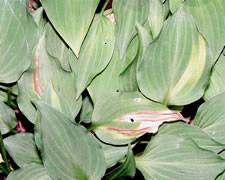http://www.golfcourseindustry.com/gci-100313-biosafe-systems-nematode-study.aspx
Plant diseases can be grouped into 3 main microscopic categories: bacterial, viral and fungal. Here is some information to keep in mind about these common plant diseases and the preventative steps that can be taken to defend against them.
Fungai
The most common plant diseases one encounters in the garden are those brought on by fungi and fungus-like organisms. The fungi reproduce via the production of spores that may be spread long distances by air or water, or they may be soil borne. Proper watering techniques and drainage are an important preventative defence since many of the fungi that cause plant diseases thrive in moist conditions. Fungal diseases can be controlled through the use of fungicides in agriculture, however new races of fungi often evolve that are resistant to many conventional fungicides. Alternatively, fungicides like OxiDate use a chemical reaction that oxidizes enzymes and proteins that make up simple cell organisms, on contact. As the oxidation happens very quickly and leaves no residual chemical, the disease has no opportunity to mutate and form resistance. Some of the most common plant diseases brought on by fungi and fungus-like organisms include, Downy and Powdery Mildew, Gray Mold (Botrytis), Fusarium wilt and Blight.
Bacteria
Bacterial diseases can occur within houseplants and greenhouse-grown varieties, but are more common in outdoor plants. This is partly due to the fact that many types of bacteria that infect plants are often transmitted by insects that create a wound in the plant, allowing the bacteria to get inside. Several types of parasites like whiteflies, scale and aphids can act as carriers of the bacteria, which is transmitted to the plant when the insects feed on it. Bacteria can also be transmitted by pruning equipment shared between infected and non-infected plants.
A two-pronged approach to bacterial prevention would include include controlling the parasites with a natural insecticide like AzaGuard. Plant wounds can be treated for bacteria using a foliar spray like OxiDate (for food crops) or ZeroTol (for ornamentals). These organic chemistries can be tank-mixed for ease of application.
Viruses
Viruses, like bacterial infections, require an opening in the plant through which the virus can get past the cell’s rigid cell wall. Humans can transmit plant viruses via grafting and parasites can also act as carriers of the virus. Unlike bacteria, viruses actually infiltrate the plant’s cells, and then replicate themselves to create more infected cells. Since the virus lives inside the plant’s cells, there is no way of removing a virus without destroying the plant cells in the process, making chemical treatments futile.
Normally plant viruses only cause a loss of crop yield. Therefore it is not economically viable to try to control them, the exception being when they infect perennial species such as fruit trees.
The US EPA has approved a newly expanded label for BioSafe Systems’ AzaGuard Botanical Insecticide/Nematicide, including expanded use rates, new pests, and two new use sites.
AzaGuard’s use rates have been expanded to allow for a greater treatment range and better efficacy against strong infestations. In some cases, these expanded rates represent a doubling of the amount of AzaGuard used per acre of treated crops.
In addition to these expanded rates, several new use sites and pests have been added to the label. AzaGuard can now be applied to mushrooms and manure piles to treat for Mushroom flies, Nematodes, and Phorid flies. New pests for other food crops include grasshoppers and locusts, mites, and chafers. Other pest groups, including flies, moths, and grubs, have been expanded to include more sub-species.
AzaGuard is a 3% Azadirachtin insect growth regulator that is OMRI Listed for Organic Use, and can be tank mixed with other BioSafe Systems’ chemicals as part of a complete pesticide program. AzaGuard is available in 32 oz. Tip N’ Pour containers providing precise measurement, and also in a 1 gallon size for larger applications.
Neem products were at the top of the list of effective treatments against the following varieties of beetle:
- asparagus beetle
- blister beetle
- colorado potato beetle
- cucumber beetle
Our neem-based botanical insecticide, AzaGuard, provides powerful broad spectrum insect control for over 300 insect species through multiple modes of action. It prevents molting between the larval, pupal and nymphal phases. It is also an effective insect-repellent, effectively reducing plant damage from insects.
Nematodes are a type of roundworm – very small and transparent, they frequently go unnoticed. However, these plant parasitic nematodes can cause significant damage to the roots and foliage of garden plants. Foliar nematodes live in and feed on the leaves and buds of plants such as peonies, hostas, chrysanthemums, begonias, columbines and azaleas.
Gardeners and landscapers with a foliar nematode problem will notice sections of the leaf first turn yellow, than purplish brown, and finally completely brown. If treated when symptoms first appear, the following application can significantly reduce nematode populations, minimizing plant damage.
ZeroTol is a broad spectrum algaecide, bactericide and fungicide based on peroxygen chemistry (27.0% Hydrogen Peroxide and 2.0% peracetic acid). The label has wide applications for greenhouse/nursery use. It can be applied as a foliar spray, soil drench, fog or mist for disease and algae control. For foliar nematode control, the recommended rate would be 1:100 applied at 5 day interval. The product works as a contact kill and has no residual benefits. Hence, applying early when initial foliar disease symptoms appear or even better if applied as a preventative (before symptoms appear) on a 5 day interval is recommended. This study proved that ZeroTol can be very effective on leaves and also in soil. The other attributes of ZeroTol is that it has no residual concerns and can be safely tank mixed with most fungicides and insecticides.

One of BioSafe System’s newer products, AzaGuard, is a broad spectrum botanical insecticide/nematicide. The active component in AzaGuard is a 3.0% Azadirachtin. Azadirachtin is a natural liminoid present in seeds of neem tree and was shown to be very effective in insect and nematode control by it’s properties as an insect growth regulator (IGR), oviposition inhibitor and also as a natural repellant.
ZeroTol can be safely tank mixed with AzaGuard and our recommendation for foliar nematode control is to tank mix ZeroTol with AzaGuard ( 1 gallon of ZeroTol + 22.5 fl.oz of AzaGuard per 100 gallons of water) and spray once every 5-7 days.
